
|   |

|   |
Maru Vazhi - The other path A journey through wounds and wonder - Bijoy Shivram e-mail: bijoyshivram@gmail.com Photos: Gaurang Anand & Team May 23, 2025 When the body becomes memory and movement turns into metaphor, we step into the world of D. Padmakumar - or Pappan, as lovingly known - a rare artist whose work resists confinement by form yet is deeply rooted in the rigour of tradition. A master of Kalaripayattu, dancer, choreographer and teacher, Pappan dwells in the liminal spaces - between the martial and the lyrical, the ancestral and the avant-garde. His latest creation, Maru Vazhi - The Other Path, is not simply a performance, but a pilgrimage through loss, survival and self-discovery. Having graced stages across the world, Pappan carries the essence of India's embodied wisdom - especially Kalaripayattu and Bharatanatyam - into global conversations. Yet Maru Vazhi is not about displaying tradition; it is an inner unravelling. Anchored in the discipline of the Guru-Shishya Parampara, yet animated by the unpredictability of lived experience, it seeks a new language - Maru Vaak - another voice, another way. This work rises from emotional and spiritual turbulence - the quiet aftermath of storms, where memories lie scattered, identities blur and belonging feels uncertain. It is in this fragile terrain that a new journey begins. We bloom. We break. We rise. This is not resilience as spectacle; it is resilience as reckoning. Clad in simplicity, carrying fragments of laughter and bruised dreams, Pappan asks: what must we carry forward and what must we let fade into shadow? 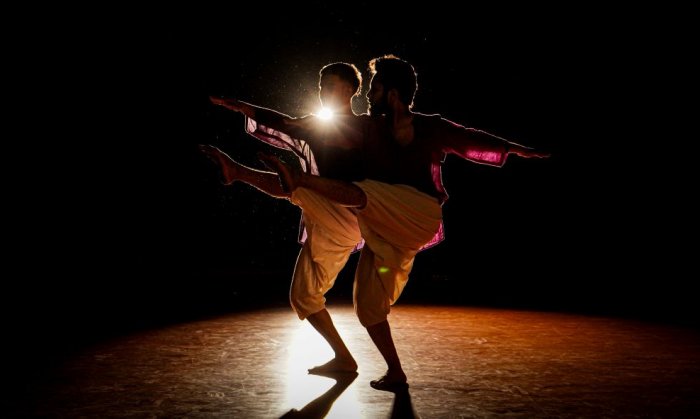 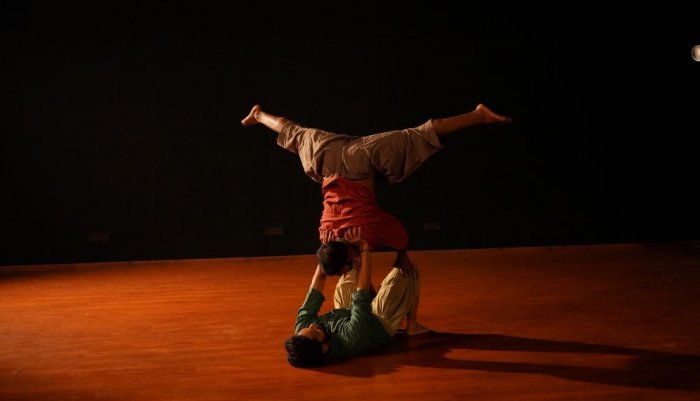 Through the combat vocabulary of Kalaripayattu and the emotive grace of Bharatanatyam, the body becomes both shield and shrine. Each leap, each stillness, speaks with visceral honesty. The aesthetic was bare, yet radiant. Choreography here was not content to decorate space - it excavated it. Silence is not emptiness but presence. We see a man walking - not toward applause, but into himself. Philosophy finds breath in his gestures. The metaphysical and the corporeal meet in movements that echo love, rage, surrender and sacred renewal. When the final bow is taken, something lingers - a hush in the breath of the audience, a shared ache. For we have not just watched a performance, but journeyed with him - through his wounds, his strength, his Maru Vazhi. One recalls a quiet line, a benediction for all who have weathered storms:"The storms taught me how to smile, and how to gather my windswept hair once more." In Pappan's world, the path may be different, but it is never alien. It is deeply human, deeply honest - and quietly luminous. Artistes like Astad Deboo and Chandralekha once carved bold new trajectories in Indian contemporary dance. Watching Pappan, one senses he walks a kindred path. Honest, human and lit from within. Storm - The new beginning A visceral genesis of Maru Vazhi The curtain rose on "Storm - The New Beginning", an electrifying prologue to Maru Vazhi - the latest choreographic odyssey by the visionary Pappan. Right from the outset, the audience was swept into a tempest of energy and symbolism - a raw, poetic interplay of discipline and abandon that set the emotional and aesthetic tone for the journey ahead. 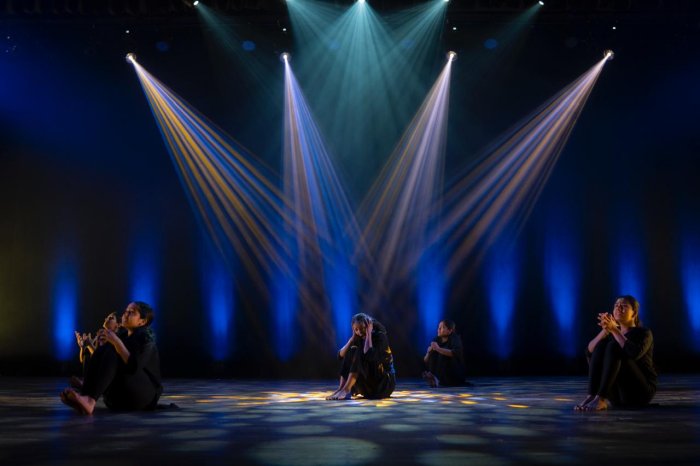 Storm Four exceptional Kalari dancers emerged, their bodies etching sacred geometry into space with the strength and fluidity that define Kalaripayattu. The choreography was a dialogue between grounded force and ethereal grace - a kinetic meditation where limbs sliced through air, feet stamped rhythms into earth and torsos twisted with elemental power. It was a dance of fire and soil - primal yet refined. As the sequence intensified, movement layered upon movement like a rising tide. Suddenly, this meticulously woven order collapsed into chaos - a storm. Yet, this was not destruction for its own sake. It was a ritual upheaval. A necessary unmaking that clears space for becoming. The storm fractured the old to make way for the new. Amid this churning, a Sanskrit shloka rose. A reverent invocation to Bhumi Devi, the Earth goddess: ॐ पृथ्वी त्वया धृता लोका देवी त्वम् विष्णुना धृता। त्वम् च धारय मां देवी पवित्रं कुरु चासनम्। A prayer across centuries, it grounded the sequence in sacred intent - a moment of stillness in the whirlwind, asking the Earth to hold the body and sanctify the stage. From that sacred stillness emerged a shift - the storm's roar softened into the brisk, intricate sollukattu of Bharatanatyam. Dancers, trained in both forms, translated rhythm into movement, Kalari's expansive combat language meeting the geometric clarity and emotive vocabulary of Bharatanatyam. This was a choreographic dialogue - tension between symmetry and disruption, structure and surrender. Here, Pappan's vision shone. The metaphor was clear - chaos did not erase, it evolved. It shaped the terrain for Maru Vazhi - the "Other Path," born not from certainty but from upheaval and prayer. This transformation was brought to life by the powerful ensemble: D. Padmakumar, Lakhan Pawar, Dhruval Solanki, Abhik Sheth, Sukant Kumar Pathak, and artistes from Parampara Academy - Garvi Nagar, Dhrishree Bhatt, Devshree Bhatt, Kavya Joshi, Yana Dedhia, Tejanshi Jani - and from Nritya Kala Kendra - Brindali Patel, Divya Rakhecha, Benita Bejoy, Priya Biju, Swastika Awasthi. The live soundscape composed by Akash Bhatt and Jayan Nair, layered seamlessly into the performance. Their music - elemental yet contemporary - amplified each shift of energy and emotion, weaving an immersive, sonic world. "Storm - The New Beginning" was far more than an opening act. It was invocation and upheaval, meditation and metamorphosis - calling the audience not just to witness, but also to feel the primal forces that fracture and forge us. It was the first step on Maru Vazhi - the other path that emerges only after the storm. Jatiswaram The poetry of rhythm and melody In the rich tapestry of Kuchipudi, Jatiswaram holds a place of quiet reverence - a piece devoid of narrative or emotive expression, where rhythm and melody take center stage. Stripped of abhinaya, it offers a pure, abstract dialogue between laya, taala and movement. Here, the eloquence lies not in storytelling but in the precise articulation of pulses, pauses and patterns - a choreography of time itself. 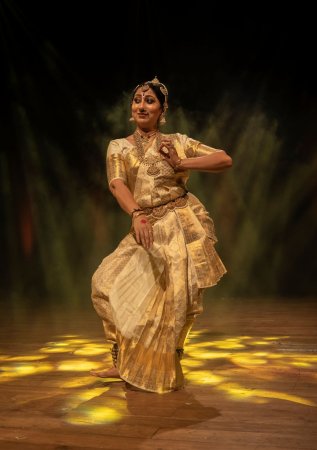 Bijal Haria This essence was brought to life with remarkable finesse by Bijal Haria, whose performance in ragam Ataana set to adi talam unfolded as a meditation on discipline, form and grace. From the first step to the final stillness, she allowed the classical structure of Kuchipudi to breathe, revealing its intricate grammar with both clarity and sensitivity. Though free of a literal story, her Jatiswaram held its own quiet narrative sculpted in rhythm. Bijal's sharp transitions, nuanced shifts in tempo and eloquent footwork created a language in motion. Brisk, staccato patterns - Kuchipudi's signature dynamism - interwoven with moments of lyrical sway, formed a seamless balance of vigour and refinement. The music stayed true to tradition, engaging in a subtle jugalbandi with the dancer - a vibrant interplay where classical rigour met contemporary sensibility. It was not just a performance but also a reminder: classical forms are not static relics but living traditions - flowing like rivers, ever renewing, ever relevant. Nadai - The walk A dance dialogue between tradition and innovation In the lexicon of Bharatanatyam, Nadai - the gait - is more than movement; an expression in motion, a rhythm of intent that carries rasa, energy and narrative across the stage. Traditionally defined by five classical gaits, each aligned with a mood or emotion, Nadai reflects the dancer's inner landscape. However, in a world of shifting identities and expanding vocabularies, can these five forms still contain the full depth of today's artistic voices? "Nadai - The Walk" responds not with rejection, but with evolution - offering a new gait born from tradition, yet alert to the spirit of now. Choreographed by Pappan, the piece reverently embraced the Bharatanatyam canon while infusing it with the grounded dynamism of Kalaripayattu. The result was a powerful fusion where each footfall carried gravity, agility and intention - not just movement, but a dialogue with the earth. It was the body speaking, not only in technique but also in truth. This new Nadai becomes a metaphor - "rooted in earth, eyes set on the sky." It honours lineage while carving a space for personal agency, contemporary reflection, and innovation. A walk that chooses its path, its direction, its story. The work found radiant embodiment in Lakhan Pawar, Dhruval Solanki, Abhik Sheth, and Sukant Kumar Pathak, whose commanding presence infused the stage with magnetic energy. Their subtle head movements, confident strides and playful charisma offered a fresh, expressive vocabulary - expanding the Bharatanatyam experience without unmooring it from its roots. Joined by the evocative artistry of Divya Rakhecha, the performance blossomed into a vibrant celebration of the form's adaptability. Akash Bhatt's music shaped the auditory space with finesse, blending classical resonance and contemporary textures. It did not just accompany the movement; it propelled it, echoing the work's core dialogue between heritage and change."Nadai - The Walk" was a bold reimagining - an offering that respects tradition, but walks forward with courage, grace and unwavering rhythm. Anveshanam - The inner awakening A musical journey within, where tradition meets the infinite In a world rushing forward, Anveshanam offers a meditative pause-a luminous journey inward that bridges time, space and spirit. Rooted in tradition yet reaching beyond the seen, it is both an exploration and a revelation, inviting artiste and audience alike into uncharted realms of the soul. At its core lies a delicate balance: the reverence for age-old forms and the bold embrace of innovation. Here, performance is not a destination but a living entity-each moment a new canvas, each gesture an act of becoming. 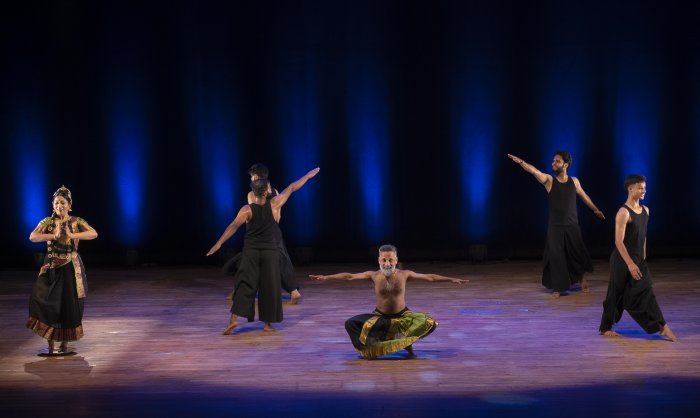 Anweshanam A duality-where ancient rhythms meet contemporary resonances-defines the spirit of Anveshanam. Echoing Nida Fasli's poetic wisdom, "Seek not just the destination, but that which lies beyond," the piece dares to look past the river's edge in search of the infinite ocean within. Jayan Nair's immersive musical compositions became both compass and vessel, carrying the narrative forward through rich sonic textures. Pappan's choreography wove the fierce discipline of Kalaripayattu with the lyrical finesse of Bharatanatyam, brought alive by the Pappan Dance Company and the evocative presence of Bijal Haria. Their synergy embodied a graceful power, their bodies sculpting silence and sound into form. Every step resonated with the sacred pulse of Alarippu. Every phrase spoke of transformation. Through this fusion of tradition and transcendence, Anveshanam became a metaphorical palace-built not of stone, but of dreams shaped in the sleep of tomorrow. Ultimately, Anveshanam was a celebration of the human spirit's yearning-to awaken, to explore and to create. It invited us to listen to the silent prayer within movement, to witness the unfolding dance of inner awakening. Vismaya - When movement paints motion In a delicate interplay of stillness and motion, Vismaya unfolds as a poetic journey where the artist dissolves into nature's wondrous embrace. It is a conversation between body, earth and spirit-each gesture, each stroke becoming a vivid homage to the fleeting beauty of the natural world. At its heart lies the artiste's timeless quest: to hold the intangible, to evoke the seen and the felt-the tender blush of a petal at dawn, the gentle sway of leaves in the breeze. These are not just impressions, but stories aching to be lived and quietly cherished. In Vismaya, the dancer and painter become twin seekers. One speaks through movement, the other through colour. Together, they explore the elemental poetry of the world around us. Yet every revelation brings a new wonder, each moment too alive to capture, meant instead to be fully felt. 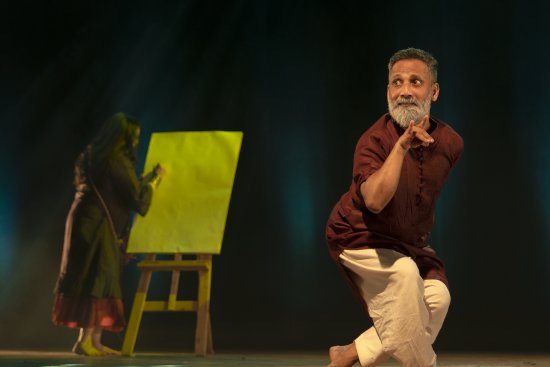 Vismaya Blending Bharatanatyam and Kalaripayattu, Pappan channelled nature's rhythms and creatures with expressive clarity-regal peacocks, buzzing bees, golden sunrises, swaying creepers and the majestic presence of wild beasts. Each movement radiated reverence, forming a rich tapestry of visual poetry. As he danced, Ketki Modi painted live on stage, translating these fleeting gestures into lasting imagery. The dialogue between her brush and his body created a mesmerizing confluence of the kinetic and the still, uniting the visual and performing arts in a sensory symphony. The soul of the piece was lifted further by the evocative music of Sikkil Gurucharan and Anil Srinivasan, whose melodies and rhythms echoed the nuances of the narrative. Hussain Kavishi's poignant poetry added layers of memory and feeling-rain-drenched courtyards, childhood scents and the sweet ache of nostalgia. Vismaya was a celebration of wonder-a quiet homage to the infinite inspiration nature offers. It reminds us that true art is born from presence, sensitivity and the courage to be moved. In the silent spaces between breaths, Vismaya whispers its truth: to live is to marvel, to create is to surrender-to the miraculous dance of life itself. Celebration - The dance of endurance In the grand tapestry of life, there are moments when the spirit surrenders-not in defeat, but in profound strength. Celebration is a tribute to this quiet resilience, a dance that echoes the unwavering heartbeat of existence and honours life's enduring will to rise, transform and blossom. This performance was a sacred offering-of surrender and strength, of joy and pain, of birth, death, wisdom and rebirth. It pulsed through every breath and being, through movement and melody, reminding us that endurance itself is a celebration of life. Guiding us through this journey, Suraj Kurup's resonant voice and multilingual narration seamlessly wove transitions between pieces. His words lingered: "If today we celebrate the soul, it is through dance and music-each rhythm, each beat telling a story of love, sorrow, valour and joy. Every moment becomes a divine offering." As a verse reminds us: "Life is always seeking reasons to smile-sometimes in the falling rain, sometimes in the depths of a dream..." The music began with the primal rhythm of breath-an invocation of existence itself. Vanitha Jayan's soulful chanting of jati bols (tha dhi taka naka jham jham...) breathed life into movement, interspersed with the potent vocabulary of Kalari: thiriya, neeki, chaadi-each syllable and step a vessel of energy, intent and grace. Choreographed by Pappan, the piece draws from Bharatanatyam and Kalaripayattu, performed by the remarkable artists of Pappan Dance Company and Nritya Kala Kendra. Precision and poetry converged in diagonal lines and mirror-like formations-reflections of harmony amidst chaos. Intricate aramandis, expressive gestures, and fluid stretches shifted between moments of playfulness and stoic endurance. The music deepened this atmosphere-the delicate tones of piano, the haunting voice of the sarangi, the resonant mridangam and pulsing drums created a sonic landscape as textured as the choreography. Solo interludes emerged like whispered truths-personal yet universal, intimate yet expansive. Each dancer's mastery of rhythm and movement became an offering of devotion and transformation. Celebration was ultimately a hymn to the soul's persistence-a moving festival of breath, rhythm and light. It reminds us that every gesture of endurance is in itself a dance worth honouring. Mask - The lost soul: A journey beyond the fašade There was once a time when masks were playful-simple joys of childhood fairs, held in wonder-filled hands, used to dream up worlds untold. Back then, masks were momentary disguises, veils of imagination. Then came a different mask-born not of play, but of necessity. The pandemic forced the world to conceal its face, not for whimsy, but survival. In that moment of collective stillness, a deeper question emerged: What other masks do we wear-ones not tied behind our ears, but etched into our very being? Mask - The Lost Soul probes this intimate terrain. It explores the invisible layers we inherit and create, shaped by families, friends, society-each one obscuring fragments of our truth. In moulding ourselves to belong, we often lose the ability to simply be. The performance unfolded like a quiet reckoning-a confrontation between the self and the echoing voice within. As a poet once wrote: "We hid within the creases of our smiles, while a voice within kept knocking- 'See me. I am still the same.'" 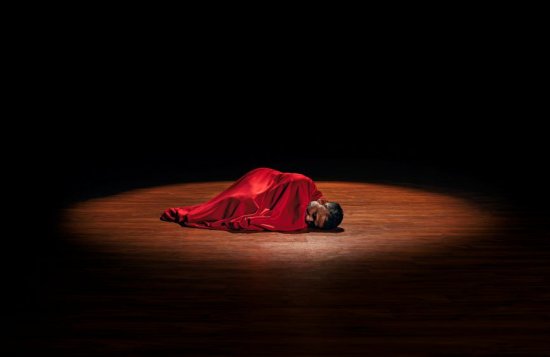 Mask Here, the mask becomes metaphor-a symbol of the facades we adopt to shield, conform and survive. The choreography by Pappan wove Bharatanatyam and Kalaripayattu with abstraction, capturing the fractured self through contorted gestures and visceral movement. A striking visual anchored the performance: a flowing red fabric binding two dancers-Pappan and a co-performer-representing the fractured psyche caught in internal conflict. Their anguished movements, at once absurd and graceful, mirrored a soul struggling against its own restraints. Suraj Kurup's voice-over deepened the introspection. His line "Da, entha kanikyane?" pierced through the silence like a quiet cry for recognition. The dancers' physical vocabulary teetered between strength and fragility, between control and collapse-evoking the tension between the face we show and the truth we hide. Neha Roy's evocative score amplified the emotional terrain-an aural undercurrent to the unspoken questions that plague the mind: Will they accept me? Can I reveal who I am? In a searing moment of climax, a dancer's body convulsed in silent desperation-raw, vulnerable and unfiltered-before dissolving into stillness. The final line lingered like a haunting whisper: "My face has silently faded away." This was not merely a dance-it was a mirror. Mask - The Lost Soul compels us to look inward, to examine the identities we perform, and the courage it takes to peel away each mask in pursuit of the self beneath. A poignant, fearless meditation on identity, conformity and the yearning for truth. Thee - an offering From the first breath, the performance unfolded as a humble homage - a dialogue with the divine source of life and art. It asked: what can we offer to the One who has given us everything? The answer was woven into every movement - the offering of self through pure artistic expression. 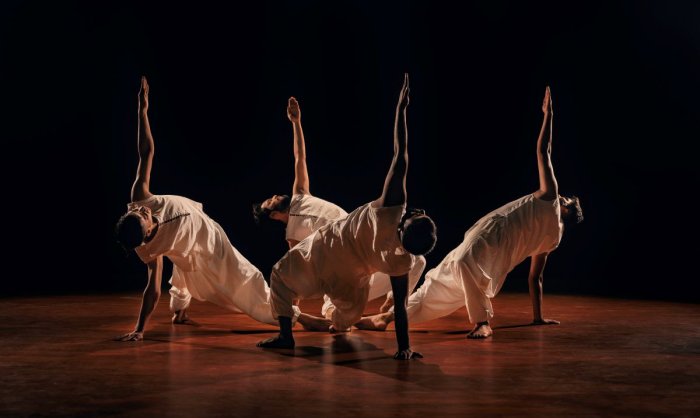 Thee At its heart, Thee reflects the human experience in all its complexity. The Pappan Dance Company, under Pappan's visionary guidance, channelled the primal energy of Kalaripayattu -fluid, powerful, disciplined-blended seamlessly with the melodic precision of Bharatanatyam and vibrant folk rhythms that pulsed like lifeblood through the narrative. Each gesture carried stories of storms weathered; love found and lost, the laws of nature, and the courage to forge new paths amid tradition. The stage transformed into a sacred space where art became prayer and performers vessels of divine longing. Among the ensemble, Dhruval and Sukant shone with emotive power, not just performing but also embodying the dance's essence. Their every glance and step invited the audience into a profound dialogue between body and spirit. The music by Akash Bhatt and Pappan wove seamlessly with the dance, shifting from meditative calm to surging intensity, mirroring the human journey's inner tumult and serene acceptance. Thee culminated in a sacred moment where rhythm, discipline, emotion, and silence united in a single pulse of existence. As the final steps touch the earth, a profound truth emerges, from the world, we take nothing; to it, we return everything. This return is not loss, but blessing - a cyclical offering of self and spirit. The evening closed with all dancers moving as one, their flowing rhythm lifting eyes toward a new path - a silent, hopeful promise of renewal and infinite possibility. In that final embrace, the stage became a threshold where endings and beginnings danced eternally. Narration by Suraj Kurup added depth and introspection, guiding the audience through the emotional and philosophical contours of the journey. The immersive lighting design, crafted by Harry Upadhyay and team, brought dynamic visual texture to the stage. 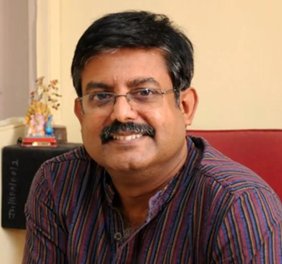 Son of journalists K Shivram and Amni Shivram, the first Malayali woman English journalist, Bijoy Shivram is an accomplished Indian classical dancer trained in Bharatanatyam and Kuchipudi. A passionate promoter of the arts and a skilled graphic designer, he currently serves as the Vice Principal of JG College of Performing Arts and the Assistant Director (Operations) overseeing 17 JG colleges. He is also the founder of Preksha, an organization dedicated to the promotion of art and culture in Ahmedabad. Since 2020, Bijoy has curated the YouTube series 'Gurudakshina - An Ode to our Gurus,' celebrating the legacy of mentorship and tradition. |